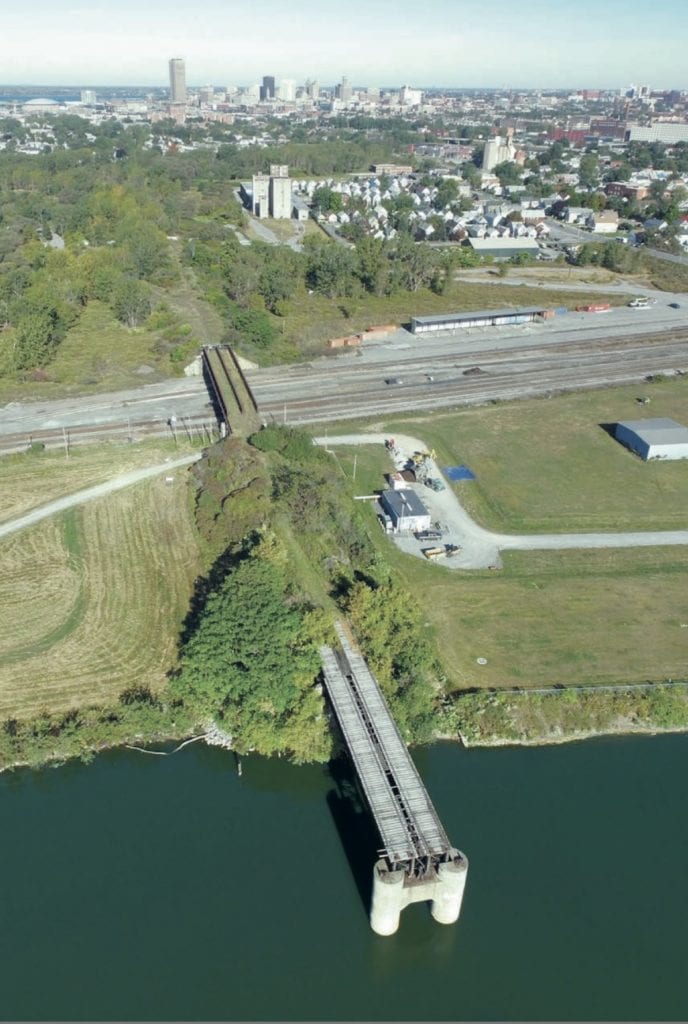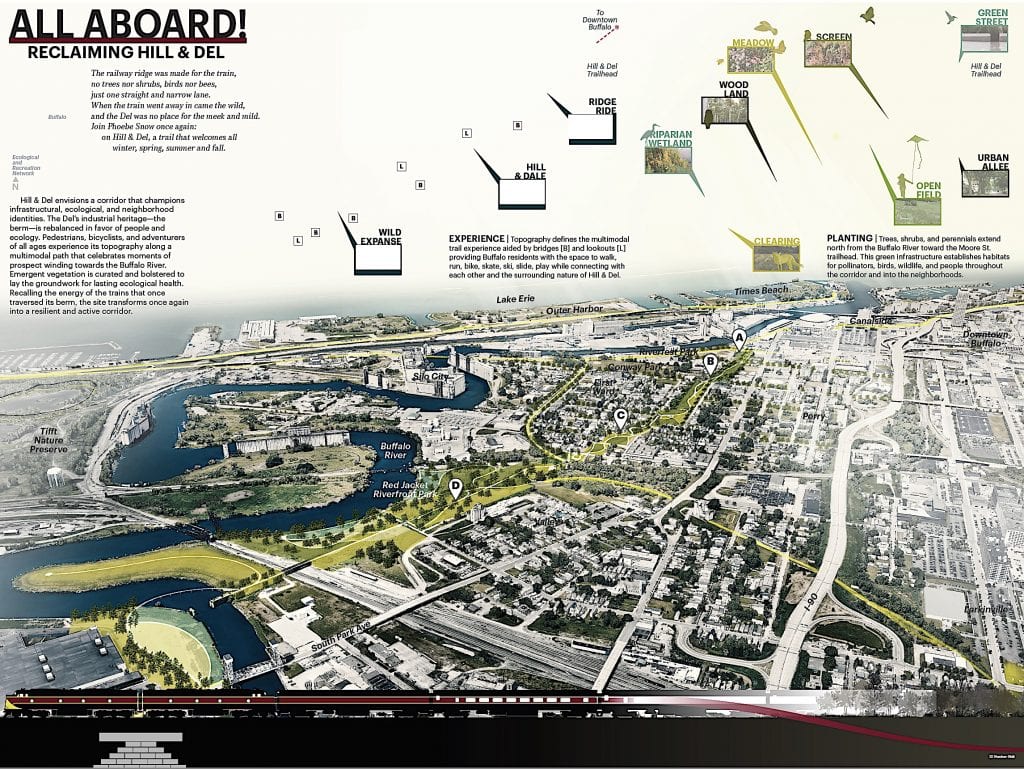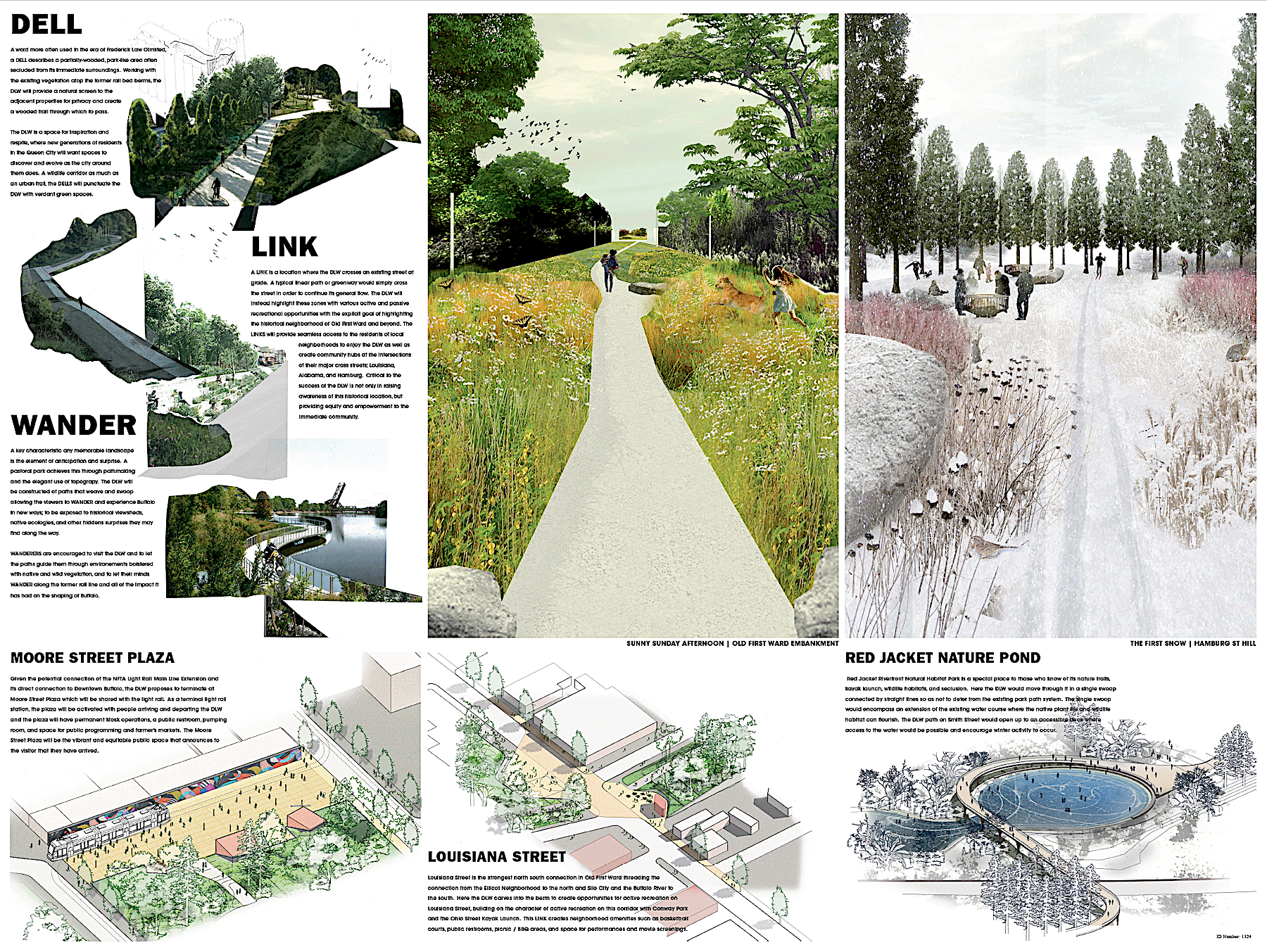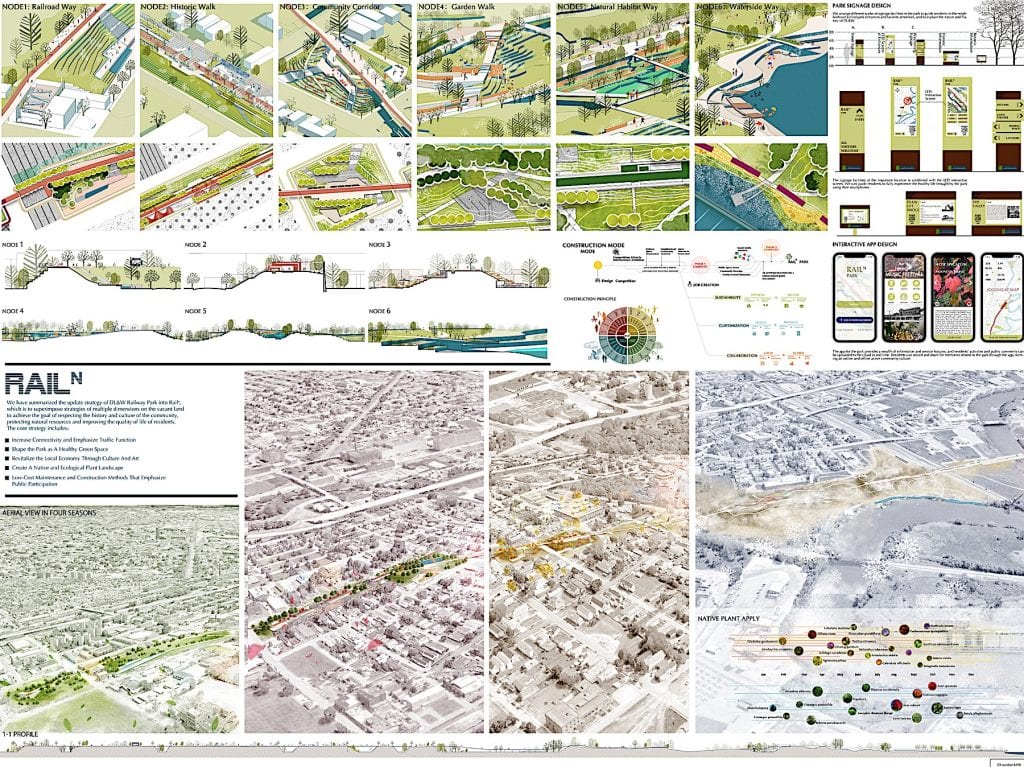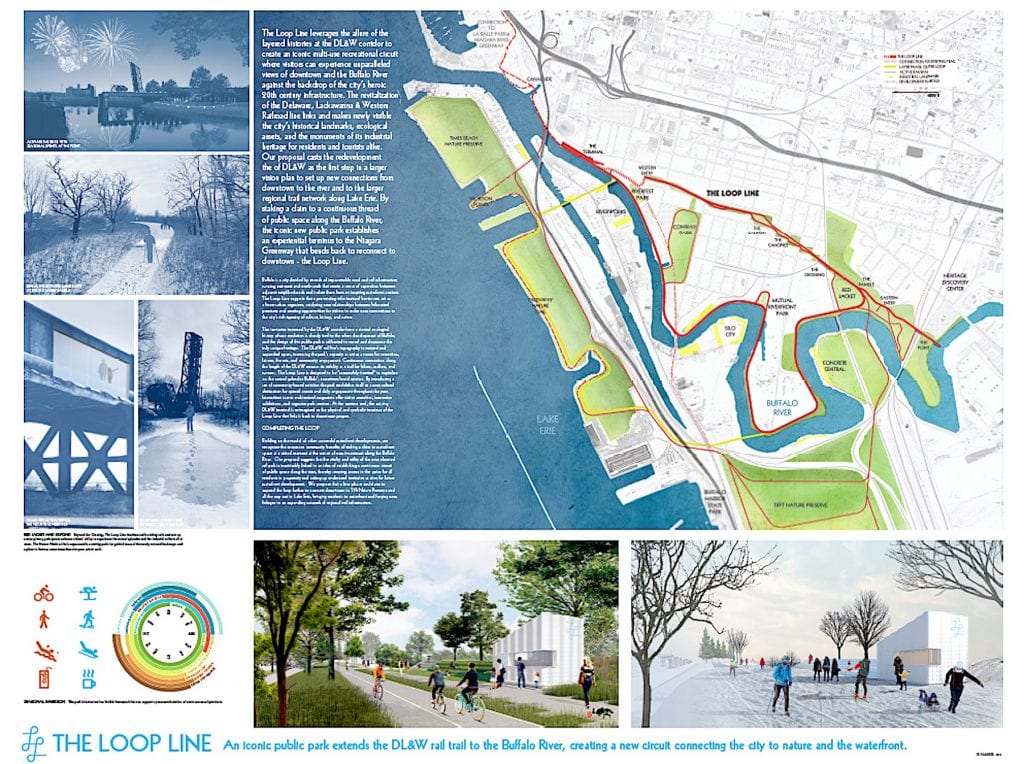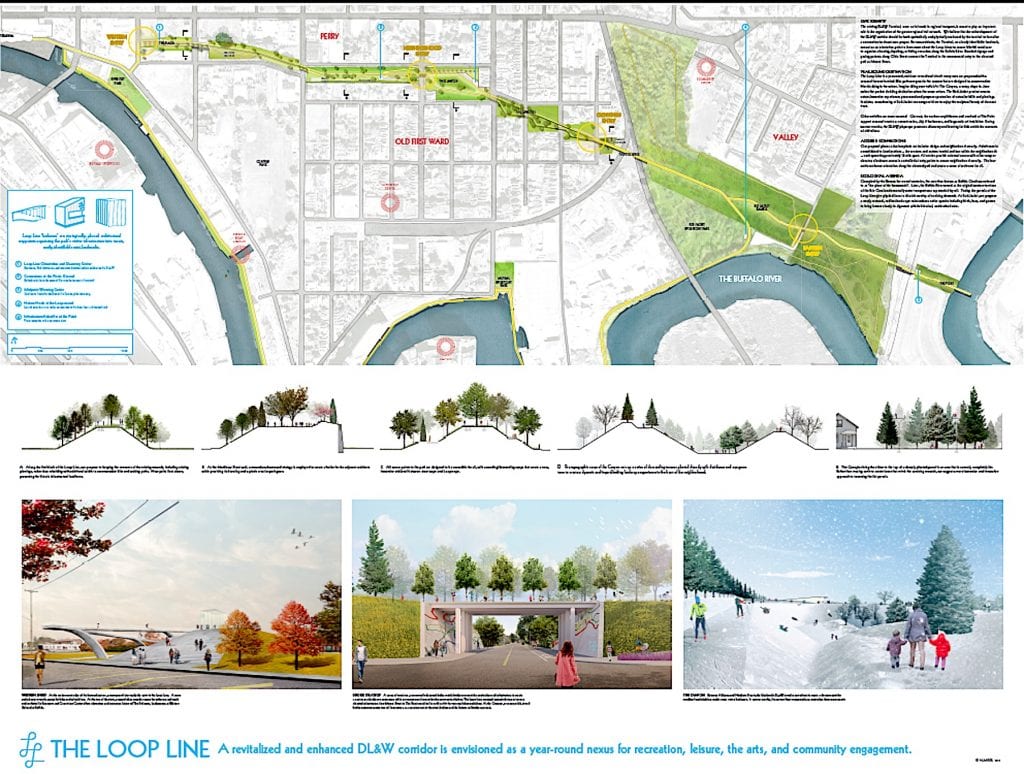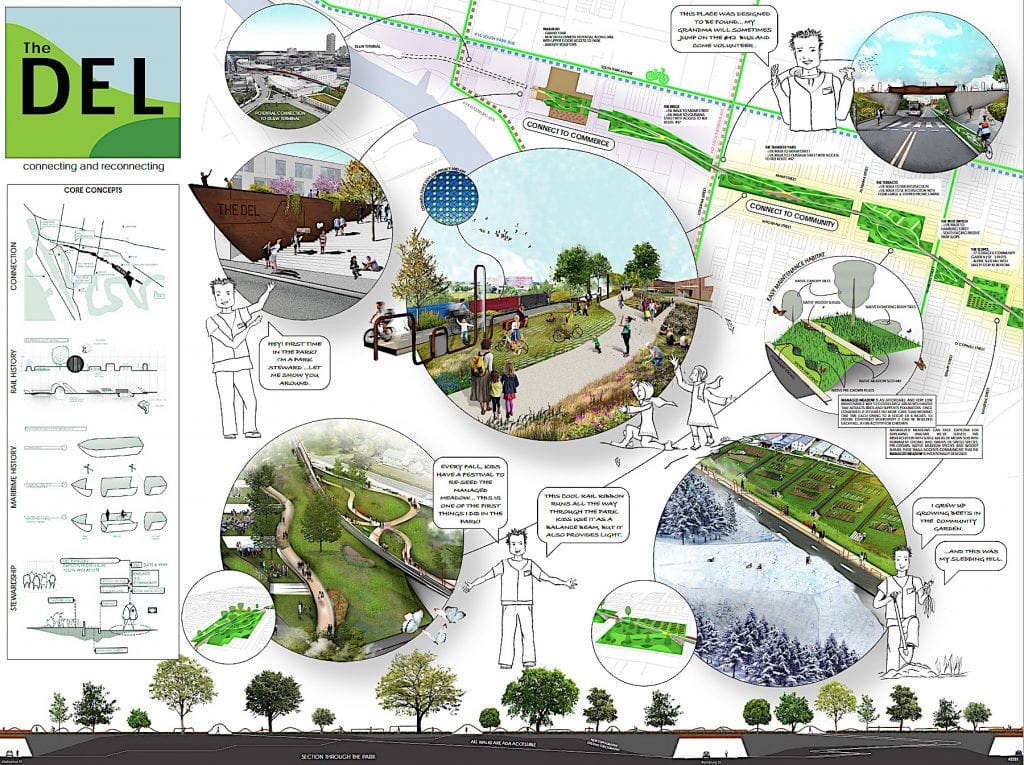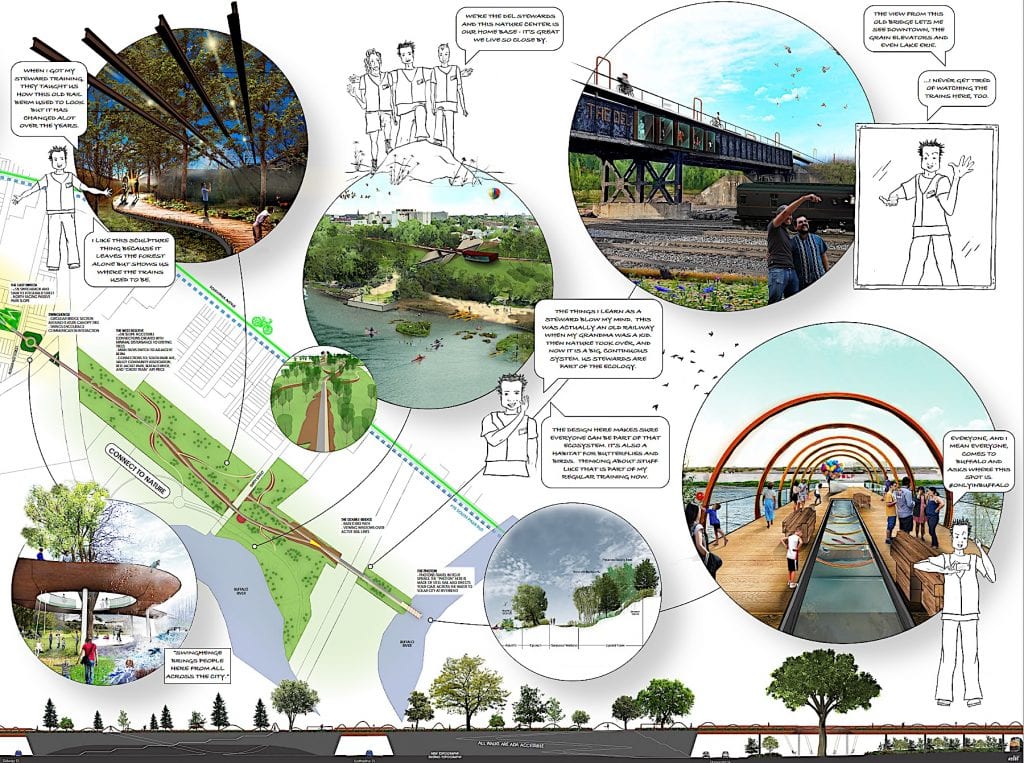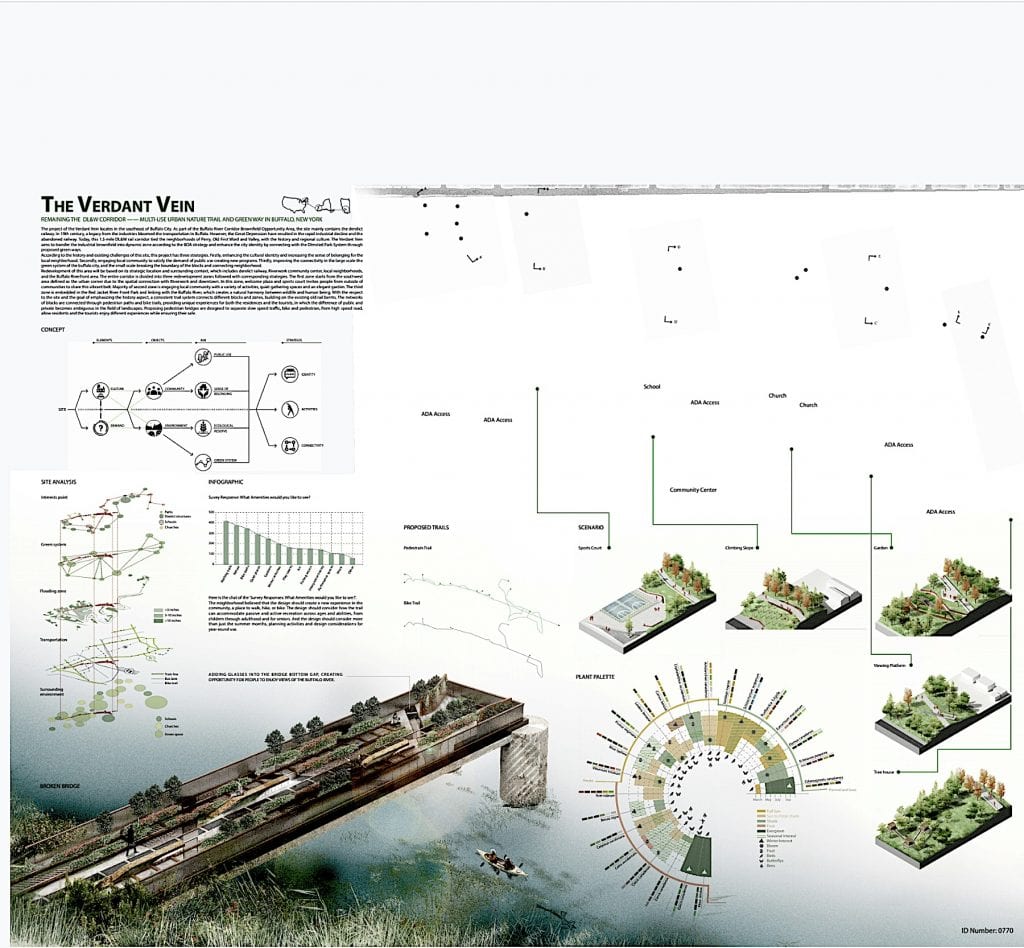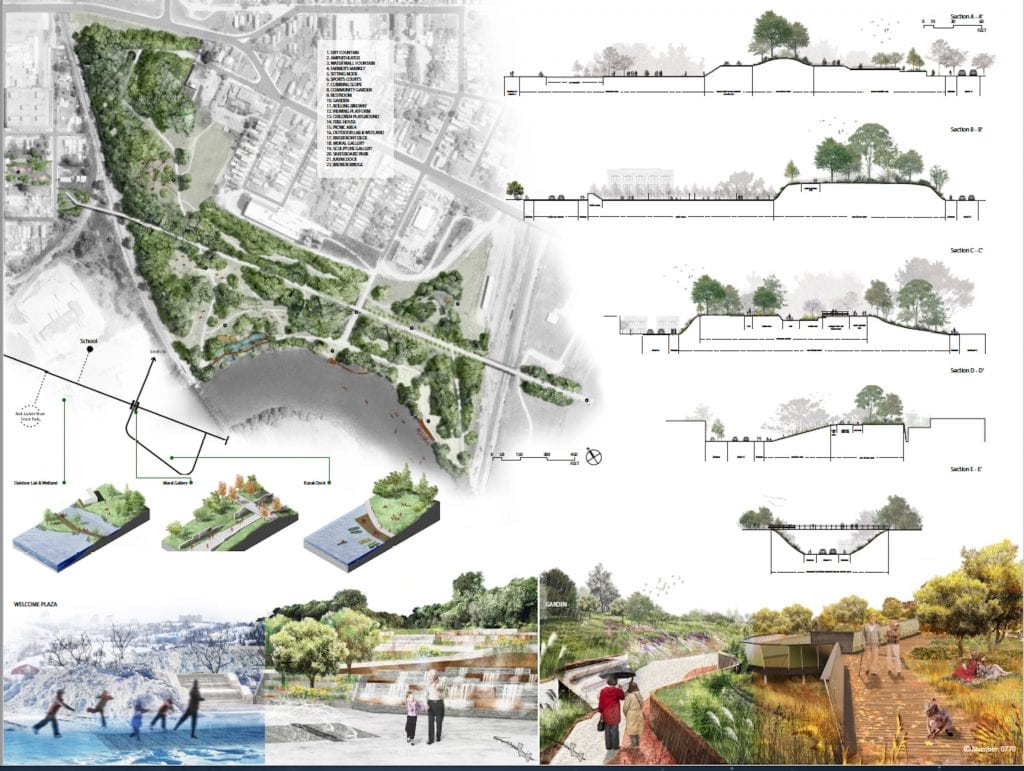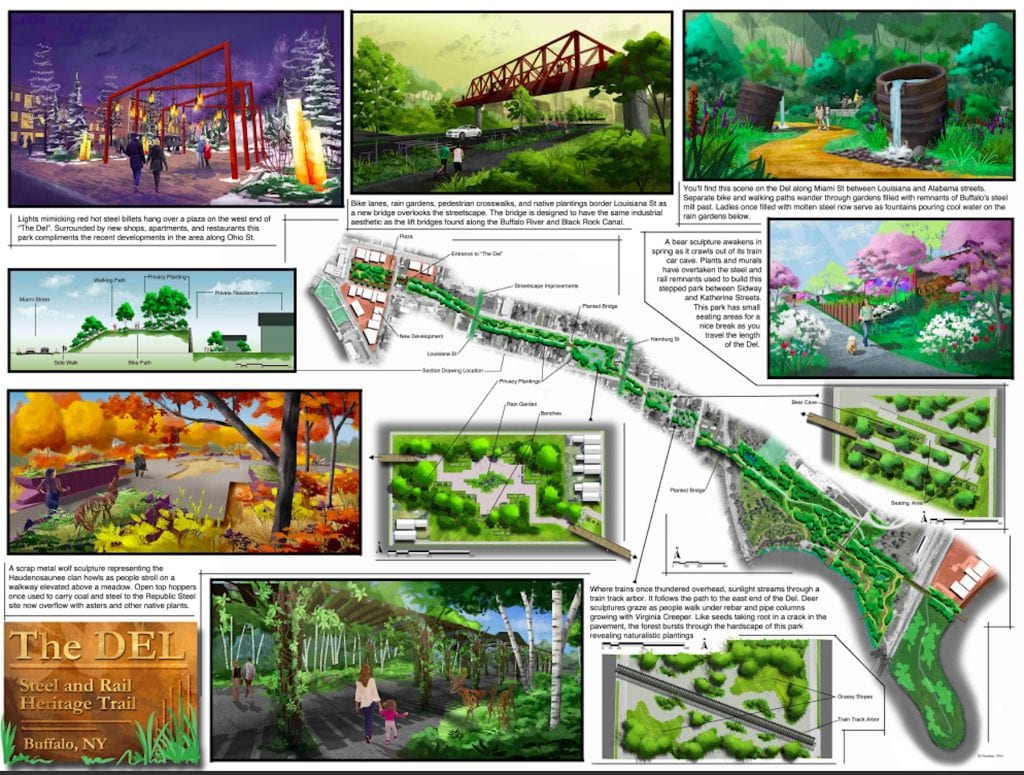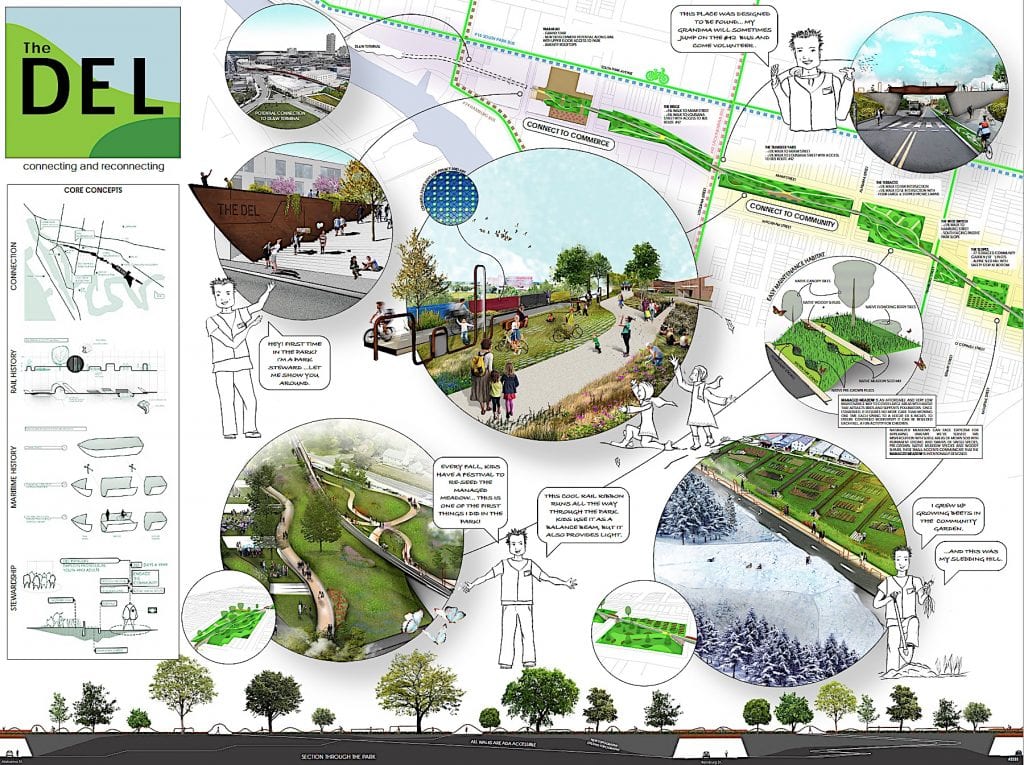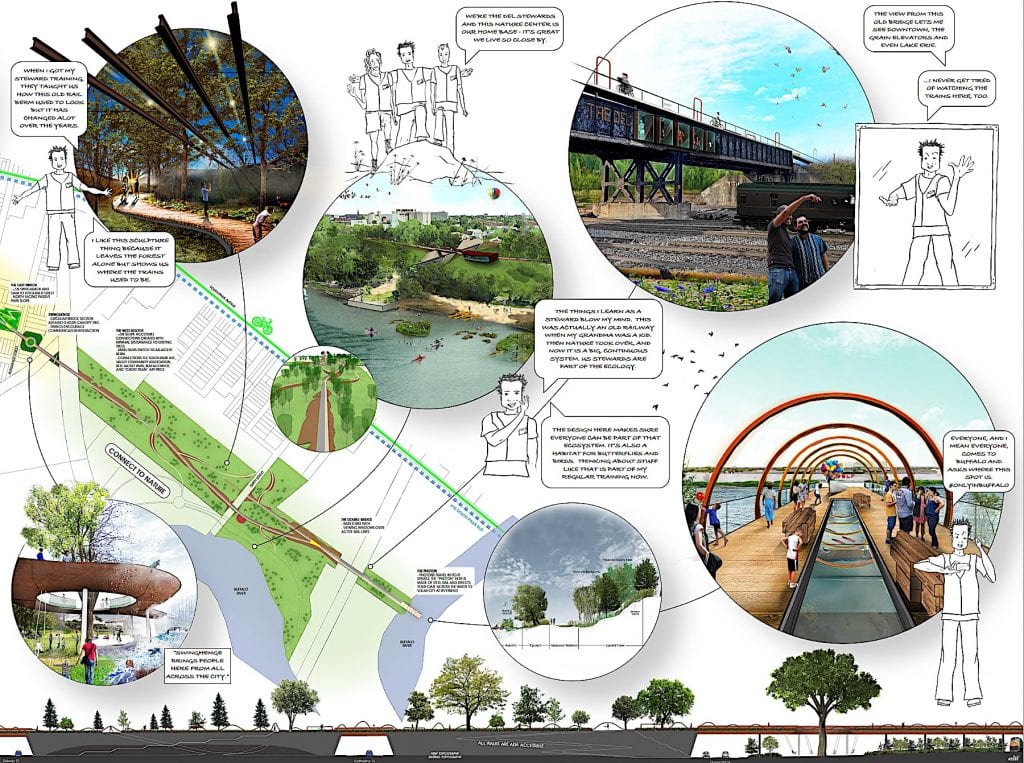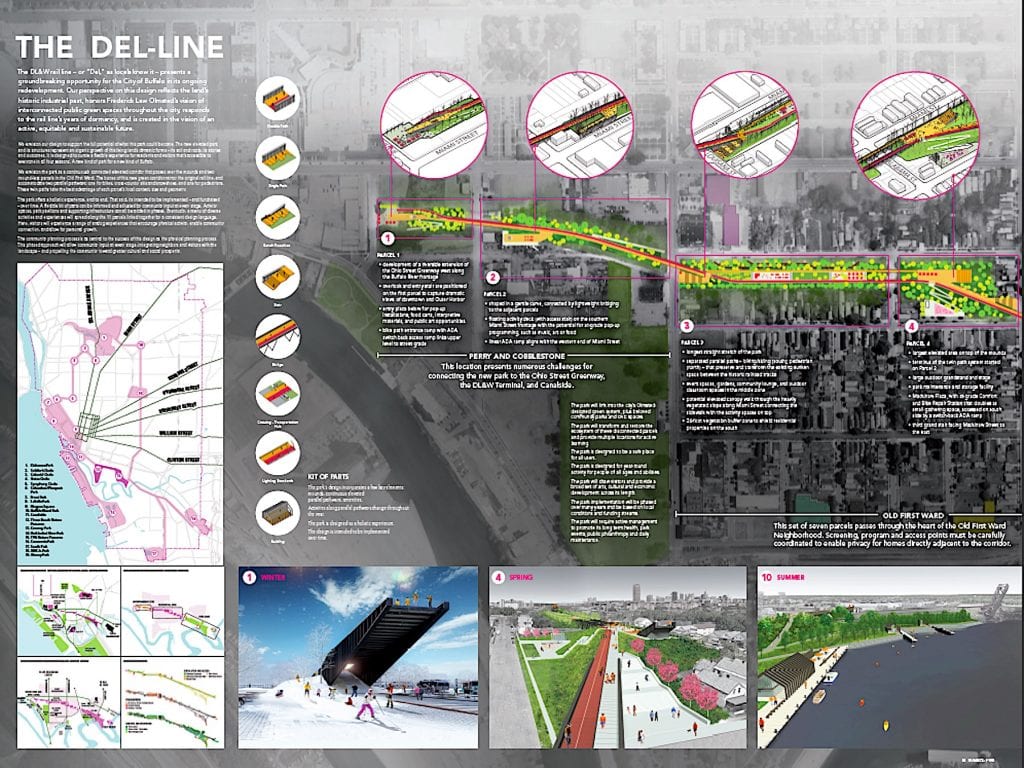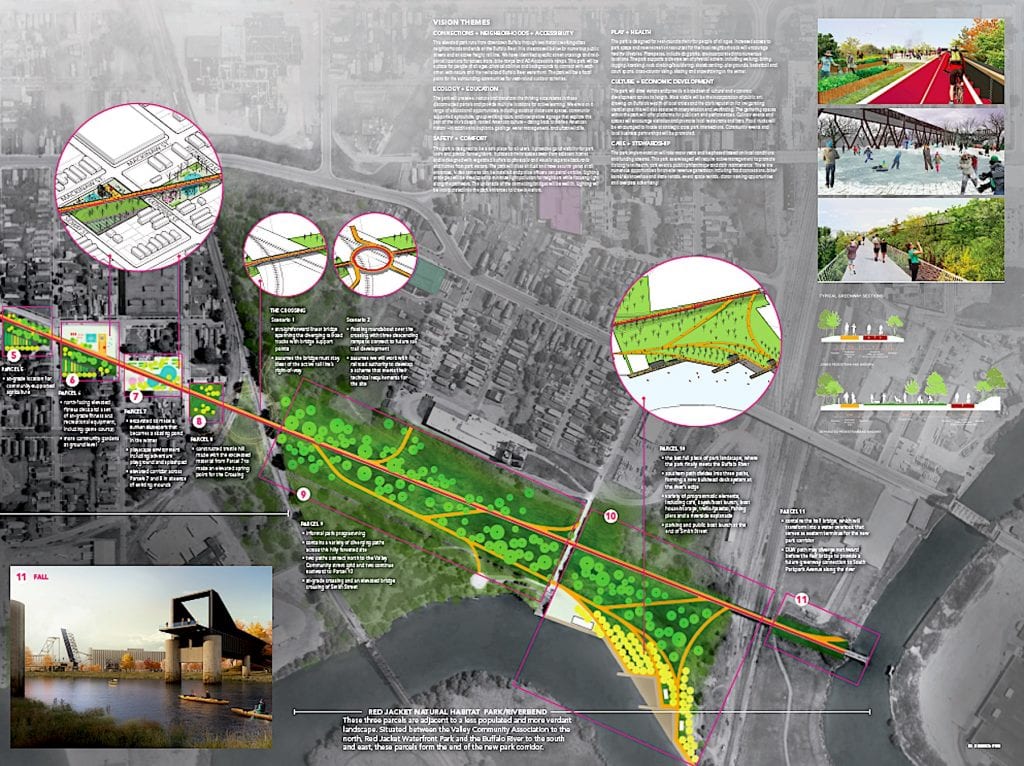Reconstituting an Abandoned Rail Line
The Rails to Trails program, which gained momentum after the1984 Federal Land Banking Law—supported by the Rails-to-Trails Conservancy—has seen over 24,000 miles of trails established where rail lines once existed. Some sites were strictly urban, while others, sometimes over 100 miles in length, were primarily rural, while others combined some of both.

Aerial view of High Bridge State Park: courtesy Village of FarmVille
The New York High Line is one of the most high profile examples of such a project in a high-density area—almost certainly modeled on Paris’ Promenade Plantée, already realized in 1993. Bridges have played an important role in both city and rural rail beds converted to trails: the Big Four bridge in Louisviile, Kentucky, spanning the Ohio River, is a relatively short, but highly popular destination. And Virginia’s High Bridge Trail State Park structure, stretching for almost half a mile in a rural area, is certainly the main feature of that 31-mile trail. Originating in downtown Bloomington, Indiana, the B-Line trail combines some of both, stretching for 5.1 miles out past the city limits.

B-Line Trail – photo courtesy City of Bloomington
The City of Buffalo and the Western New York Land Conservancy recognized the DL & W roadbed as a logical site, not only for a future trail, but for a design competition as a source for the 21M project’s masterplan. The competition brief was fortunately not overly specific, and gave competitors some room to explore some innovative solutions. Current park-like project in the works these days are no longer just about vegetation, but placing the focus on the experience of the user, whether biker, jogger, or walker.
Although the DL & W Greenway measured only 1.5 miles, because of the topography, neighborhoods, and the Buffalo River as an important element in the background, there were numerous challenges to address. One of the most obvious were the numerous roads and traffic arteries intersecting the trail: how to lessen the impact of these as an impediment to the users. Most entries recognized the necessity to make room for points of interest along the way, whether it was to use a knoll as sledding possibility or designate locations as lookouts. To be viewed in the distance, Buffalo’s famous grain silos on the river have always been one of the city’s major sightseeing attractions.
The Competition
Administered by Kishore Varanasi, Director of Urban Design and Principal at cbtand Anthony Armstrong, Principal at Make Communities, the expert competition jury consisted of:
- Charles Davis II, Assistant Professor of Architectural History and Criticism, University at Buffalo
- Ken Greenberg, Principal of Greenberg Consultants/ author of Walking Home – the life and lessons of a city builder
- Sara Heidinger, President of the Old First Ward Community Association/ co-owner Undergrounds Coffee House & Roastery
- Chris Reed, Founding Director of Stoss Landscape Urbanism/ Professor in Practice of Landscape Architecture and Co-Director of the Master of Landscape Architecture in Urban Design Program at the Harvard University Graduate School of Design
- Robert Shibley, Professor and Dean of the University at Buffalo School of Architecture and Planning/ UB Campus Architect/ Senior Fellow at the UB Regional Institute
- Janne Sirén, Director of the Albright-Knox Art Gallery
- Ana Traverso-Krejcarek, Manager of the High Line Network, at Friends of the High Line
The organizers were intent on including the public, encouraging their input into the process from the beginning and, once the entries were on public display, providing them with an option to vote for a “Community Choice Award.”
Well advertised, the competition drew almost 100 entries from throughout the world. During the second stage of the adjudication process, the entries where whittled down to a shortlist of 30 finalists. From those, the jury announced their final rankings:
First Place
“All Aboard! Reclaiming Hill & Del” was submitted by MNLA,a NYC-based landscape architecture firm. Their design was created by team members Molly Bourne, Greg Leonard, Katherine Cannella, Ilana Cohen, Katie Drummond, Sonya Gimon, Emily Gordon, Rae Ishee, Johanna Phelps, and Yelena Zolotorevskaya. (Entry #0348)
Second Place
“The Dell, The Link & The Wander” (DLW) was a joint effort by: Marvel Architects– a NYC-based Landscape Architecture, Architecture & Placemaking firm with team members Yadiel Rivera, Tyler Silvestro, Yanick Lay; Buro Happold– Planning & Engineering firm with team members Alice Shay, Cristobal Correa; Patrick Cullina – Horticulture & Design firm; and NOWHERE Office– Graphic Design & Wayfinding firm with team member Yeju Choi (Entry #1324)
Third Place – Tie
“Railn” was designed by a team of 6 graduate students of Landscape Architecture from Beijing Forestry University, including Ou Xiaoyang, Ni Yongwei, Lin Qiao, Liang Shuyu, Li Jiayi, and Ai Xin. (Entry #4190)
Third Place – Tie
“The Loop Line” was designed by Kerry O’Connor of OSA, an emerging design practice based in Brooklyn, NY. (Entry #7836)
Honorable Mention
“Del Buffalo: Connecting and Reconnecting” was designed by a Buffalo-based team comprised of Seth Amman, Dylan Burns, Nicole Lipp Duffin, Matt Wattles, Stephanie (Cole) Adams, Daniel Seiders (Entry #2535)
Honorable Mention
“The Verdant Vein” was designed by team ‘Echo’, which is comprised of four master students in the field of Landscape Architecture from Cornell University, including Lingyi Xu, Zhuohan Xie, Zhuojia Lou, Zikun Zhang (Entry #0770)
Community Choice Awards
First Place
“The Del: A Steel and Rail Heritage Trail” was designed by Matt Renkas, who has a degree in Landscape Architecture from SUNY Environmental Science and Forestry. Matt is currently a firefighter for the City of Buffalo. (Entry #9163)
Second Place
“Del Buffalo: Connecting and Reconnecting” was designed by a Buffalo-based team comprised of Seth Amman, Dylan Burns, Nicole Lipp Duffin, Matt Wattles, Stephanie (Cole) Adams, Daniel Seiders (Entry #2535)
Third Place
“The Del-Line” was designed by Cannon Design of Grand Island & Supermass Studio of NYC. Team Members include Michael Tunkey, John P. Reed, Taewook Cha, Luke Johnson, Mark Nowaczyk, Nhan Bui, Ryan Koella, Sean Eno, Luyao Kong, Nicole Sowinski (Entry #9190)
Conclusion
The competition winner, “All Aboard! Reclaiming Hill & Del” by the New York City firm, MNLA, was a very thoughtful, carefully laid-out solution, both in terms of enabling users to navigate the trail in a most logical and interesting manner, while paying close attention to the site’s ecological potential. The use of a model-like aerial view of the site on a large scale undoubtedly helped viewers toward a comprehensive understanding of the designers’ intent—so important when a jury is confronted with almost 100 entries.
Here it should be noted that the “Community Choice Awards” went almost exclusively to local Buffalo area designers. In the words of Western New York Conservancy’s Executive Deputy Director, JaJean Rose-Burney, “The competition remained anonymous throughout. There might have been some word spreading amongst local teams, of course. I do have a lot of confidence in the community choice award process, however.
At each public event, many people told me and our team how much they liked the submission that ultimately won the community choice award. This winning submission was done in a style that really captures attention (bright colors, beautiful imagery, a fairy tale theme), which I think was just a good strategy for a public voting competition. I think the local teams were able to capture the spirit of the place in a way that really resonated with people who live here.”



























